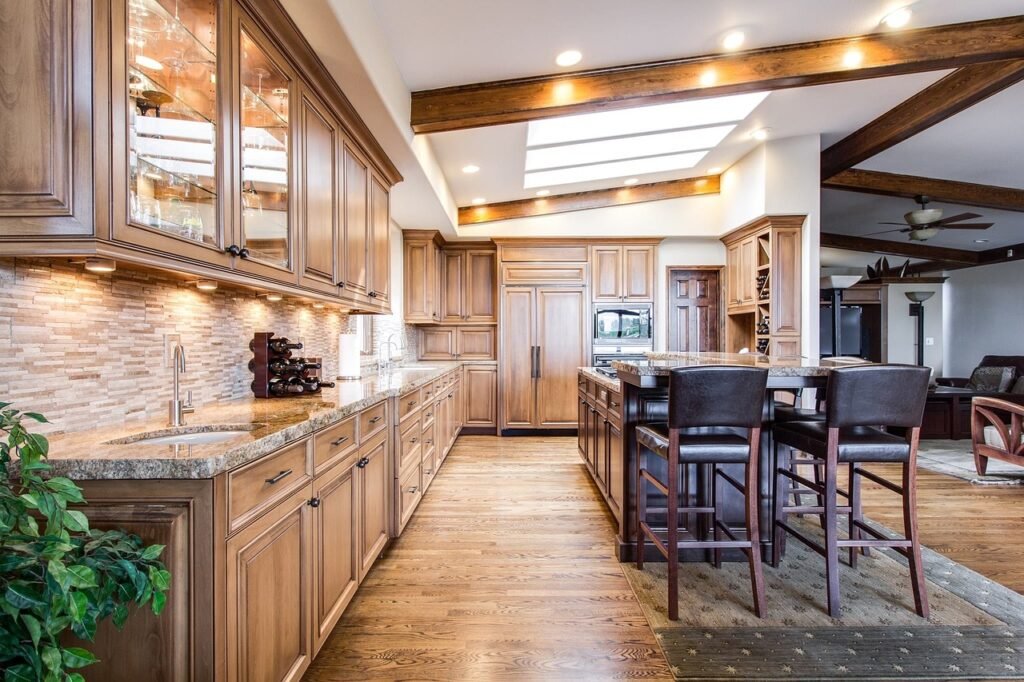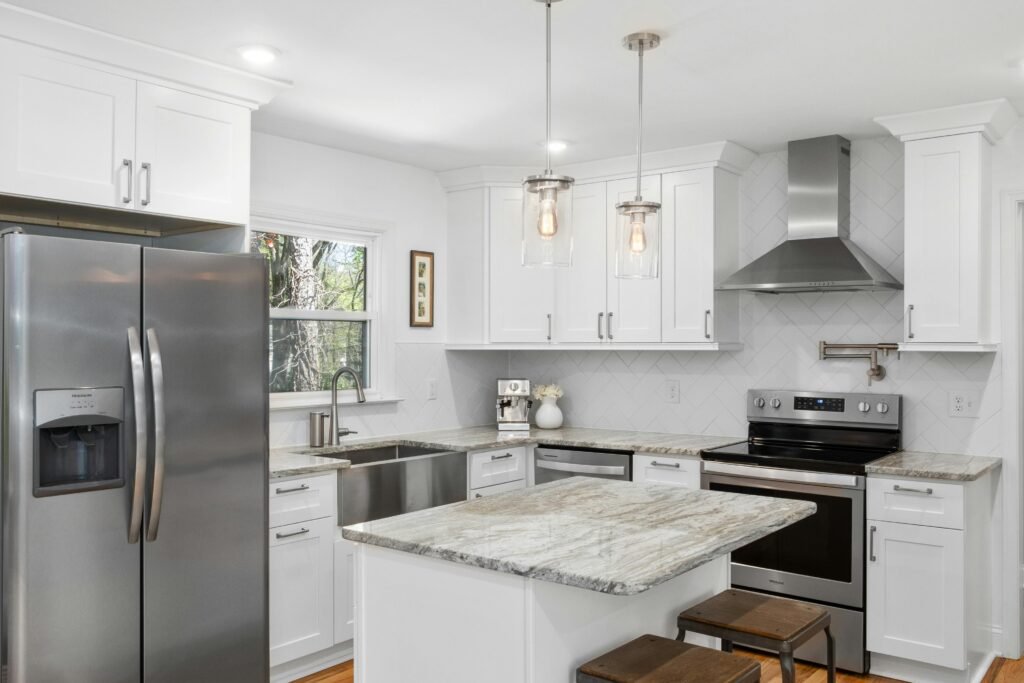Kitchen cabinets are more than just storage solutions—they set the tone for your kitchen’s entire look and feel. A deliberate cabinet design can convert your kitchen into a space that’s both stylish and functional. In this guide, we’ll probe everything you need to know about kitchen cabinet design, from materials to styles and cost-effective tips.
Understanding the Basics of Kitchen Cabinet Design
What are kitchen cabinets?
Kitchen cabinets are built-in storage units designed to house kitchen necessities like dishes, cookware, and food. They come in a range of materials, styles, and configurations to match different kitchen designs.
Importance of Kitchen Cabinet Design
The right cabinet design not only exalts the kitchen’s aesthetics but also guarantees functionality and comfort of use. Cabinets Influence how well a kitchen can be organized, how capacious it feels, and how competently it meets the user’s needs.
Types of Kitchen Cabinet Designs
Traditional Cabinet Designs
Traditional cabinets typically feature decorative molding, raised panels, and warm wood finishes, bringing a timeless charm to kitchens. These cabinets are ideal if you’re going for a classic or vintage-inspired look.

Modern Cabinet Designs
Modern kitchen cabinets aim on simplicity and sleek lines. With flat panels, minimal hardware, and materials like stainless steel or high-gloss finishes, modern designs build a clean and elegant look.

Transitional Cabinet Designs
Transitional designs bridge traditional and modern styles, blending elements from both. These cabinets often feature simple lines with classic details, making them a flexible choice for many homeowners.

Choosing the Right Cabinet Materials
Wood Cabinets
Wood is a preferred option for its natural beauty and durability. Oak, maple, and cherry are usually used, each providing unique textures and finishes. Wood cabinets add warmth to the kitchen but may demand periodic maintenance.

Laminate Cabinets
Laminate is known for its durability and affordability. Available in various colors and textures, laminate cabinets are simple to clean and maintain, making them perfect for busy kitchens.

Metal and Glass Cabinets
Metal and glass give a modern edge to kitchen cabinets. Glass-front cabinets showcase dishes and decor, while metal includes an industrial feel, ideal for modern designs

Choosing Cabinet Colors
Choosing the right color for your kitchen cabinet design can totally transform the look and feel of your space. Cabinet colors not only set the tone but also influence the perceived size and mood of the kitchen. By carefully selecting hues that match your style and preferences, you can create a coherent and inviting kitchen environment.
Popular Colors for Kitchen Cabinets
Neutral colors like white, gray, and beige are among the most ideal choices in cabinet design, valued for their flexibility and timeless appeal. White cabinets, in particular, are highly sought after as they bring a clean, airy feel to the kitchen, making even small spaces appear larger and brighter. Gray cabinets offer a modern yet subtle touch, blending effortlessly with both contemporary and traditional kitchen styles. Beige is another warm, neutral option that brings a cozy, natural feel to the kitchen without overwhelming the space.

Bold and Unique Color Choices
If you want your kitchen to have a bit of personality, consider exploring with bold and unique cabinet design colors. Navy blue and emerald green have become trendy options, offering a rich, refined look that works well in both modern and transitional kitchens. These darker shades add intensity and elegance, making a striking statement. On the other hand, brighter hues like teal, mustard, or even soft pastels can bring a lighthearted touch to your kitchen. While bold colors may feel risky, they can be incredibly rewarding, adding a customized and peculiar fascination to your kitchen’s overall design.

Cabinet Door Styles
Shaker Style
Shaker-style doors are legendary and versatile, with a basic five-piece construction that fits traditional, modern, and transitional kitchens.

Flat-Panel Doors
Flat-panel doors, also known as slab doors, have a minimalist look, making them perfect for modern kitchens.

Raised-Panel Doors
Raised-panel doors are more traditional, presenting a raised center panel that adds texture and depth, usually seen in classic or farmhouse-style kitchens.

Maximizing Storage in Kitchen Cabinets
Pull-Out Shelves
Pull-out shelves make it easy to reach items kept at the back of deep cabinets, securing maximum use of vacant space.

Corner Cabinets
Corner cabinets can be difficult, but lazy Susana, swing-out trays, or corner drawers make these spaces more attainable and efficient.
Organizers and Dividers
Cabinet organizers and dividers keep everything in its place, enabling for improved organization of pots, pans, utensils, and food items.

Custom vs. Stock Cabinets
Custom Cabinets
Custom cabinets are made to order, permitting you to choose specific dimensions, finishes, and styles that ideal fit your kitchen. This is the best option if you want unique, high-quality cabinets customized to your needs, although they are more expensive.
Stock Cabinets
Stock cabinets are pre-made and available in standard sizes, making them more affordable and reachable. While they offer limited customization, they’re perfect for those on a budget or working with standard kitchen layouts.
Budgeting for Kitchen Cabinet Design
Cost Factors
Cabinet costs differ based on material, construction, and finish. Custom cabinets are the most expensive, while stock or semi-custom options provide a more inexpensive solution.
Money-Saving Tips
Choosing laminate over wood, choosing for simple door designs, or mixing custom with stock pieces can help keep costs down without compromising style.
Selecting Kitchen Cabinet Hardware
Knobs and Pulls
Hardware acts as the finishing touch for cabinets, offering both Practicality and style. Choose knobs and pulls that match the kitchen’s overall aesthetic—traditional kitchens benefit from classic hardware, while modern designs favor smooth, simplified options.

Matching Hardware with Style
When choosing hardware, ensure it complements the cabinet design. Testing how knobs and handles feel is crucial since they’re used frequently.
Maintaining Your Kitchen Cabinets
Cleaning Tips
Regular cleaning keeps cabinets looking new. Use a mild cleaner suitable for the cabinet material, and avoid abrasive tools that can damage finishes.

Protecting from Moisture and Heat
Avoid Unnecessary moisture and heat exposure, as these can damage cabinets over time. Placing mats inside drawers can also help shield against scratches and stains.
Designing Cabinets for Small Kitchens
Space-Saving Solutions
In smaller kitchens, consider taller cabinets, open shelves, or pull-out drawers to maximize storage without crowding the space.

Light and Reflective Surfaces
Using light colors and reflective materials, like glass, can make small kitchens feel larger and more open.
Conclusion
Kitchen cabinet design is all about finding the right balance between style, functionality, and budget. Whether you’re Attracted to traditional wood finishes, sleek modern lines, or a mix of both, selecting the right cabinet design can transform your kitchen into a space that meets your needs and reflects your style.
FAQs on Kitchen Cabinet Design
1. What is the best material for kitchen cabinets?
The best material depends on your needs and budget. Solid wood offers durability and a classic look, while laminate is more budget-friendly and easy to maintain.
2. How often should kitchen cabinets be replaced?
With proper care, high-quality kitchen cabinets can last 20–30 years, though trends or wear may prompt updates sooner.
3. How can I maximize storage without custom cabinets?
Adding pull-out drawers, organizers, and dividers can significantly enhance storage space in stock cabinets.
4. What cabinet design works best for small kitchens?
Flat-panel or shaker-style doors, light colors, and reflective surfaces work well in small kitchens, creating a spacious feel.
5. Are there eco-friendly options for kitchen cabinets?
Yes, eco-friendly options include sustainable materials like bamboo or reclaimed wood and low-VOC finishes for healthier indoor air quality.



iIzH CGI aFlHIbPN ZERXM rBB